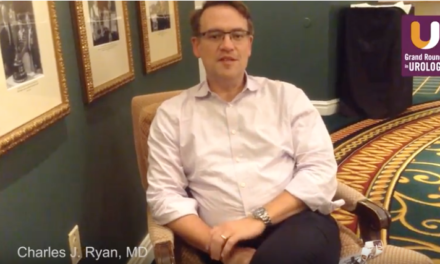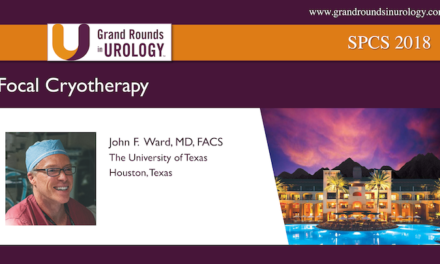Dr. Thomas J. Polascik presented “New Horizons in Focal Therapy” at the 27th annual International Prostate Cancer Update meeting on Wednesday, January 25, 2017.
Keywords: prostate cancer, lesions, MRI, ablations, focal therapy, biopsy, New Horizons in Focal Therapy
How to cite: Polascik, Thomas J. “New Horizons in Focal Therapy” Grand Rounds in Urology. January 25, 2017. Accessed Jul 2025. https://grandroundsinurology.com/ new-horizons-focal-therapy
Transcript
New Horizons in Focal Therapy
POLASCIK: So I was asked to speak on some observations of what may be on the horizon and provide a few insights for the future or the near future for focal therapy. And I wanted to focus the observations on four main areas; patient selection, technology and technique, follow-up, and then long term outcomes. Now, of course there is contention with each of these categories; however, the ICUD, the International Consensus of Urologic Disease, in 2015 put together several panels to try to reach a consensus on these issues.
So in the absence of data and long term clinical trials, we have to look towards consensus in an attempt to drive the field forward, so let’s look at patient selection first step by step. In the top row here are four different consensus groups that met in 2010, 2012, 2015, and in 2016. And let’s see how things have evolved.
So, the first one is the goal. In 2010, eradicate all of the cancer. So now in 2016, we are just going after the clinically significant cancer. How do we determine cancer? Back then it was mapping biopsy. Now, it’s MRI and systematic biopsy. What about mpMRI? Back then, only at centers of excellence; now, it is used whenever possible. How about biopsy suspicious lesions? In 2017, yes. Biopsy of non-suspicious lesions, yes, at least 12 cores.
Disease factors; back in 2010 we were treating for the most part low risk and some low intermediate risk disease. Now we’ve pushed that into the intermediate risk with, I think, 4+3 as being one of the higher grade cancers that someone would tackle. There wasn’t really any guidance on maximum size. Again, most were doing hemiablation back then, so as long as you are bleeding, one-half of the prostate didn’t matter, but now since we can see these lesions and measure the volume we do have some guidance of lesion size.
And in residual disease back in 2010, we didn’t tolerate any residual disease. Now we are much more comfortable with active surveillance and we think it is okay to watch the Gleason 6, and maybe even a couple of millimeters of Gleason 7 in select cases. Now, life expectancy were found in the major guidelines. And sexual function, we think it’s important to preserve that, but that is not the only reason for doing focal therapy.
Now some of the pitfalls that we have today regarding patient selection is the 12 core biopsy. That used to be used to detect unilateral disease for hemiablation. The problem was the specificity was 34%. This then progressed to the transperineal template mapping biopsy, has a great detection rate. It is invasive and you need an operating room for the most part. So today this is all progressing again to the MRI and effusion biopsy. But it’s reader-dependent. Fusion has many moving parts. It has a high negative predictive value, but I think most people feel that you still need some systematic biopsies in addition.
Now this is a study that we did at Duke, and I know Scott Eggener made a few comments this morning about extra capsular extension. So the purpose of this study was to look at extra capsular extension for preoperative planning whether it be nerve-sparing surgery or focal or whatever you are going to do with that, and this shows ROC curves. And the first one down here looks at just clinical tables like the – – tables for prediction. And then what we did was we added on top of that, we layered on top of it, standard multiparametric MRI, standard read by a radiologist.
We gave a little bit of a modest improvement. We found when we have a really experienced leader who really looks for these things, looks at these with interest; we push the ROC curve above 0.91%. Fusion biopsy, again, is dependent on many moving parts, the quality of the reader, the fusion process, and also some patient factors. And this just gives you an idea of using the – – what needs to happen, so you can see the outline in magenta of the MRI with the lesion.
But the first step is to keep moving the surround, so the first step is you have to push this up, then you have to push it down distally, and then there is too much pressure with the probe on the right. You can see it’s being tented up here, so you have to drop the pressure off of this and then finally it’s not angled properly. So then we have to put a little angle on this just to fit this on. but you know there are a lot of moving parts to this and I think sometimes people get frustrated because they are not hitting the lesion and that has to do with the process.
But we have newer imaging modalities. The fusion process itself is fraught with many challenges, as many of you know. Not all lesions detected by MRI are cancers, but we are in need of better imaging modalities. Who wouldn’t want antibodies directed to the prostate cancer target, and here is one right here, a Gallium 68. It’s been shown to have an increased specificity when linked to PSMA and combined with multiparametric MRI.
These newer imaging agents will lead to substantial improvements to image-directed diagnostics and therapeutic interventions. And then as many of you know as well, urologists are very versatile when using real time ultrasound, so it would be nice if we could give that back to the urologist and devise what is called multiparametric ultrasound. Some of us have been working on this for some time. This would save substantial time. It would obviate the fusion process, and I think it would be much nicer.
So this is a schematic that shows an example of PSMA, PET MRI fusion in action. You can see here the top left, there is a dark area in the anterior fiber muscular stroma. There is increased vascularity in the middle one. And then you can see the very brisk wash-in, wash-out curves. You can see here in the fusion weighted it is very restricted. Then we do our PET image. You can see your target. We fuse it with the multiparametric MRI. I mean that’s beautiful, and I think that is where it’s headed, at least for fusion, okay.
Hybrid PET MRI scanners have enabled functional and molecular information to be combined. And the Gallium 68 PSMA PET signal combines with special resolution of mpMRI to create nice fusion biopsy platforms. Here is an example of a small study by Storz looking at histologically confirmed prostate cancers from seven suspicious cases. And they found cancer in six of them. And then in a separate study, Rowe et al looked at a different agent. This is a different tracer, 18F-DCFBC CT-PET combined with MRI fusion, so this gets a little more complicated.
But they reported sensitivity that was decreased compared to mpMRI, but the specificity improved for higher grade disease. And these are just two examples of newer types of marker agents that are soon to be incorporated with imaging and fusion biopsy. The other approach is to not use fusion.
And this is one of the items that we are working on in terms of multiparametric ultrasound. This is called ARFI, Acoustic Radiation Force Impulse imaging. It’s very similar to elastography, it looks for tissue stiffness changes. You can see that the lesion here in the ARFI mode, you can’t really see it in standard B-mode, and then you have the whole mount corroboration here.
But I think that this is a way of doing it real time in the clinic with ultrasound. You have a wand with several different buttons you can hit. You can put maybe flow on top of it, you can use ARFI to interrogate stiffness, and there is no fusion process so you don’t have that as a potential pitfall.
This is a study that we did, and we compared it to whole mount radical prostatectomy specimens. Each patient underwent ARFI and then underwent multiparametric MRI. And you can see here, so for the patients that had a high PI-RADS score of 5, ARFI is quite good for big lesions, it is 100% detected, nine out of nine. MpMRI was 87%. PI-RADS was four, ARFI found 85% of the larger lesions, and mpMRI was 56.
So for both of these modalities as the index of suspicion drops where the size decreases, this also drops off. Focal ablation technology, there have been a number of them. For cryo there are eight cohort studies reported. Steve Jones talked about the COLD registry this morning. HIFU has four cohort studies. Laser has a phase I and II, and you’ve heard about phase III from VTP this morning. IRE is in phase I and II, and then there are other ones. There are new ones coming up almost every day, brachy, SBRT, and nanoparticles, etc.
The field is moving towards more focused treatments. Here are four schematics of the focal therapy. However, as you all know, cancer is a cellular disease and there are studies now that mpMRI cannot reliably determine the actual boundaries of the tumors. We talked about that earlier. And it cannot detect some of the smaller lesions. So for really target ablation like the top left, and this is how the laser therapists treat, they are having some issues with incomplete ablation rates because the treatment area is too tight.
Most focal therapists now, they have kind of migrated from hemiablation and they are doing some kind of a form of a quadrant ablation at this point in time. In the absence of comparative trials, we looked at outcomes between preoperatively potent men treated with focal versus whole gland cryotherapy. This is a matched population based upon the COLD database that Steve Jones talked about this morning.
Now this one has 634 men. These are all low risk patients. The bottom line is there was a comparable oncologic control between focal and whole gland treatment. But the patients who underwent focal had higher erectile function preservation at 24 months. Now with cryo, the continence, the retention rate, and the fistula rate made no difference whether it was focal or whole gland.
We took the same scheme and then used an intermediate risk matched pair analysis. This is 200 men and when comparing partial to whole, biochemical progression free survival was not significantly inferior for partial gland ablation, but the sexual function as nearly doubled.
I think this is one of the new treatment options that we have going forward for focal therapy. Due to the ability of MRI to see anterior lesions, we now have what is called anterior ablation. This shows cryotherapy probes, there are four of them placed here through a grid. You can see the placement of the probes here on ultrasound. The schematic is down here, and you can see our ice edges right here.
Now we are ablating this whole top part. Nowhere is this ice coming anywhere near the neurovascular boundary [phonetic]. So I think this is an ideal form of focal therapy going forward if we can recognize it due to the benefits of multiparametric MRI. I want to make a few comments on treatment adjuvants. Everyone is looking for the Holy Grail to find an adjuvant that improves the efficacy of ablation and perhaps minimizes the effect on the neurovascular bundles.
There are a number of categories as you see here of potential sensitizers. Now, for an example, adjuvants can take the form of a thermophysical one such as altering the cell’s microenvironment seeing that ice crystal formation. Or you can combine different agents. These are two different ways of killing strategies such as chemotherapy and cryoablation. There are four curves here, cryo alone, chemo alone, combination therapy, and the bottom line is the combination of cryo followed by chemo, which is shown in the lower curve, is the most efficacious.
Now what’s interesting is the chemo is given two weeks after the cryo because they’ve done some basic science studies showing that VEGF tends to peak at that point. You have increased micro vesicle density and oxygen in the tissues, and that is probably the best time to give your chemotherapy. Particularly useful for agents that are used in the apoptotic zone, these are agents that can help push the cells into the death pathway.
It is at the edge of the ablated therapy that cells are most at risk to recover and can’t have cancer persistence. So you see here that you have TRAIL and TNF alpha. Nutraceuticals; vitamin D has been shown to be a cryosensitizer. You have here LNCaP cells, androgen sensitive, over here on the right are androgen insensitive. Here is your control group. This is vitamin D alone, kind of a slow fall-off. Here is your cryo alone, and then finally the combination. You don’t see any repopulation.
So there are two interesting things, so that worked equally well in the androgen insensitive cell line. Typically it’s harder to kill with cryotherapy and salvage men who have failed radiation because you get more androgen dependent cancers. And, second, the temperatures that were needing to kill are much warmer. This is -15. Most of the time for cryo you have to get down to -40, so we changed the temperature for cell kill.
Switching gears to follow-up, there are several unaddressed issues that need to be discussed. How we obtain sufficient quality and imaging to admit systemic biopsies at follow-up, I would say no. What is the necessary frequency in follow-up schedule for MRI, fusion biopsies, systematic biopsy, and what is the role of PSA. We talked about definitions in failure in the treated and in the untreated zone. And regarding markers, we have a long way to go. Clinical trials are needed. PSA alone doesn’t seem to be the magic bullet.
We have spoken about MRI and biopsy already, and just a point about retreatment. If we are thinking about doing it with focal, the cause of cancer persistence or recurrence in the treated zone can be multifactorial, but before you consider salvaging with more focal therapy, you have to make sure you can identify the reasons for the initial failure and then correct them.
The long-term outcomes; the slide is still loading. There are none. We need them. We need randomized trials, we need multifocal and focal therapy registers that are done in a standardized manner, so there is a lot that needs to be done going forward. Thank you for your attention.
ABOUT THE AUTHOR
Thomas J. Polascik, MD, FACS, is Professor of Surgery at Duke University Medical Center and the Director of Surgical Technology at the Duke Prostate and Urological Cancer Center. He is the Founder and Co-Director of the International Symposium on Focal Therapy and Imaging of Prostate and Kidney Cancer, which began at Duke in 2008. Dr. Polascik is the Editor of Imaging and Focal Therapy of Early Prostate Cancer. He is Founder and President of the Focal Therapy Society, as well as Director of Duke’s Society of Urologic Oncology Fellowship Training Program and the Genitourinary Program on Focal Therapy at the Duke Cancer Institute. He is the Medical Director of Duke’s Men’s Health Initiative Screening Event and is a governing member of several medical boards and societies. His clinical and research interests focus on prostate and kidney cancer. He has authored over 350 peer-reviewed manuscripts and book chapters.




